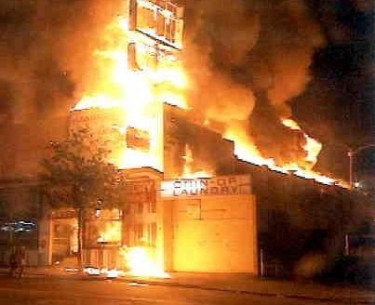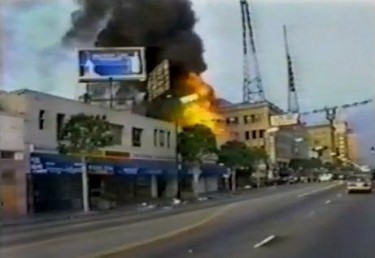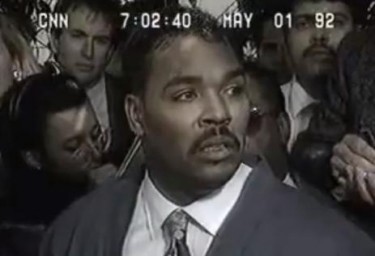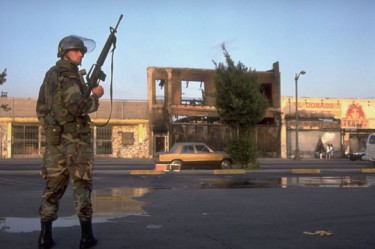Los Angeles, April 29 -- May 4, 1992

April of 1992 seems like paradise now, in certain ways. The economy was bouncing back nicely, thank you, even if it wasn’t yet fully obvious. We users of Prodigy, Compuserve and AOL were all yapping incessantly on our BBSes, and we were about to try out that newfangled “e-mail” thing. “Are you on e-mail?” people would soon be saying. Bill Clinton had only just clinched the Democratic nomination. (That Arkansas governor! Did you know he was a Rhodes Scholar, too?)
But the year before, in March, a man named Rodney King had been tasered twice and then beaten half to death by a pack of Los Angeles police officers. The beating was secretly caught on tape (via an enormous Sony Handycam) by plumber George Holliday, from his apartment balcony. The grainy video was made public, and it was shown on TV over and over. Nobody could believe how terrible it was, or even that Rodney King had lived after having suffered “11 skull fractures, permanent brain damage, broken [bones and teeth], kidney damage [and] emotional and physical trauma” (according to the complaint he eventually filed against the city.)
Rodney King was on my mind a lot when the news first came out about Mark Duggan, the father of four who was shot to death by police in Tottenham last Thursday. Like the violence against King, the death of Duggan was the match that lit the fuse of a bomb that spread violence across a whole metropolis. How and why this happened in Los Angeles seems to connect in a lot of ways with the catastrophe in London.
The initial part of the story of the Los Angeles riots was rather different, though.
Just over a year after the attack on Rodney King, on April 29th of 1992, the criminal trial of his assailants came to an end, and all four of the officers involved were acquitted of having used “excessive force” against him. The whole nation gaped in disbelief. Even then-President George H.W. Bush, who appeared to be cultivating an air of total cluelessness most of the time, was openly incredulous at this news. And then all hell broke loose.
At the time, my ex and I were living in a second-floor loft at Pico and 4th Avenue, pretty much across the street from Jewel’s Catch One, the landmark nightclub. That is to say, in the south part of Los Angeles proper, a mostly black and Latino neighborhood. We had this little business, designing and manufacturing overpriced tchotchkes for the home. We designed house numbers for Crate and Barrel, we sold absurd little photo frames to Barneys and Bergdorf Goodman.
I was four months pregnant, and beginning to lumber a bit.
Just a few hours after the acquittals, a truck driver named Reginald Denny was pulled out of his truck at the intersection of Florence and Normandie, where a mob promptly beat him to a pulp and bashed his skull in; his injuries were worse than even Rodney King’s, and the whole sorry scene was caught on camera by a helicopter hovering above, and broadcast live. Nobody could tear himself away from the TV that day, so we were all watching helplessly as it happened. Here is something that many may have forgotten: Reginald Denny, a white guy, was rescued by a black guy named Bobby Green, Jr., who saw the beating taking place on live television, realized that it was going on nearby and rushed out to help.
But things would only get worse and worse from there.
Most of our friends were protesting the verdict, with varying degrees of civility. (I, alas, was too pregnantly incapacitated to participate in any demos.) Ellie, a charismatic gravel-voiced dyke and auto mechanic who contrived despite her long blonde hair to be the butchest thing going, joined the mobs that were overturning police cars and whatnot downtown. Other friends were making furious phone calls to every politician and news outlet and writing howling protests of every description.
On the second day we stood and looked out the window for a very long time and saw the most surreal things. Our place faced mostly north, but the smoke from the south was visible all around us by then. Its plumes drew nearer and nearer until the whole sky darkened with soot, turning a lurid, opaque rust color. A car full of shouting boys raced down Pico, their fists thrust outside the windows.
We went out anyway, just to the market and to do errands. In such circs. there is no way of knowing how or when it’s become too dangerous to venture out; you just go about your life, in hopes that the chaos won’t find its way in somehow. Because of course the farmers’ market in Santa Monica is open, of course it is, and Ralph’s too. So it was that we drove through Koreatown, just to the north of us, and it was full of tension, in a way that was gnarlier than the tension around our place. The shops and little businesses in our own neighborhood were all but abandoned, but here the bigger, more prosperous retailers were not going down without a fight. This probably was the scariest scene of all: a Korean retailer (or so we supposed) on the roof of his electronics place, dressed head to foot in camouflage gear (including matching cap, with bill) and brandishing a great big shotgun. What was more incredible? That he’d “dressed up” for this thing, or that he’d chosen to wear green camouflage gear in order to patrol a concrete roof? The real answer: that suddenly there was a Korean guy with a huge shotgun on the roof of this building on Olympic Boulevard.

The looting and burning began in our neighborhood that day. This would grow increasingly weird; a big woman brought her three little kids with her to do a spot of looting at the liquor store across the street. There was a lot of broken glass around, and clearly the authorities were completely overtaxed, nowhere to be seen, so these little kids looked very vulnerable to me, and I was afraid for them. Yet there was a party atmosphere out there, too, a terrible excitement. These kids — the youngest must have been six or seven — came out of the store, loaded down with bags of stuff. The mom stopped in the middle of the sidewalk and popped open a bag of stolen potato chips and ate them placidly as she walked along. Not only was she not scared, she was totally calm. Having fun, even. An astonishing, indelible sight: a tall, majestic woman in a kitenge and matching turban, sashaying down the middle of the street with two six-packs of malt liquor. Less than a quarter of a mile away, a whole huge shopping center was in the process of burning to the ground.
“Slim,” I said, “if they set this place on fire, I am for sure going to fall off that ridiculous emergency ladder and break my legs and have such a miscarriage.” So we decided to drive to Pasadena, where we spent the next 24 hours glued to the television in my sister-in-law’s apartment, paying particular heed to the news helicopter footage, from which we tried to determine whether or not our place was burning.
A friend described the scene from a high window at Sepulveda and Santa Monica Boulevard, well to the north of the fires and looting. You could watch the arsonists’ progress on the horizon as they torched a building, he said, then five minutes later another building a little north, then five minutes later another… nobody really knew how far it would go.
People were hauling their loot down the street; huge televisions, even furniture. The most memorable, an enormous round dining table that this guy was struggling to roll along on its edges, over the asphalt. Much of this loot looked like more trouble than it was worth, and as if it would arrive at its destination, wherever that was, in a very sorry state. A lot of the images of the London looting have a similarly senseless, almost ridiculous quality. They remind me of Louie Anderson’s comment on the LA riots; he said some friends had invited him to “go looting” and he was all “eh, I’m tired.” Then his face became animated. “But get me somethin’!”

Mark Duggan, alas, won’t be coming back to pacify London the way Rodney King did Los Angeles. Appearing on TV on the third day of the riots, he said: “People, I just want to say, you know, can we all get along? Can we get along? Can we stop making it, making it horrible for the older people and the kids? … It’s just not right. It’s not right. It’s not, it’s not going to change anything. We’ll, we’ll get our justice… They won the battle, but they haven’t won the war… Please, we can get along here. We all can get along. I mean, we’re all stuck here for a while. Let’s try to work it out. Let’s try to beat it. Let’s try to beat it. Let’s try to work it out.” By the end, 57 people were killed, and many thousands injured. It took nearly a month before the last of the soldiers left my battered city.
Civil disturbances like these begin as a genuine reaction to injustice, from a sense of grievance that has been simmering for a long time. The feeling of oppression manifests itself in different ways. For one thing, there’s this materialist idea that a person is to be valued by his possessions, and it doesn’t much matter how he acquires them. The “valuable” people are protected by the authorities, and those without “worth,” as in “net worth,” are not entitled to that protection. “Haves” and “have-nots,” we say. The people who count, in their fancy cars and houses, as opposed to the people who don’t, who are liable to be beaten in secret by the police. There is actually quite a lot of truth to this assessment, speaking as someone who has lived in wildly varying environments and circumstances.
There was such a similarity of feeling in the comments from residents of Tottenham, who also seemed to believe that the police treated blacks as nobodies, people without dignity or rights. “Have-nots,” in short.
But then maybe you go and grab all this stuff and it’s not going to fix you. Not if you steal it out of a broken window, and maybe not if you steal it in a boardroom either, come to that. We all know this deep down, I believe, and, in 1992, I got such a strong feeling watching this poor kid with his enormous half-wrecked dining table that those who participate in looting understand the emptiness of greed better than anyone. Can the roots of the reduced crime rate in Los Angeles have been set down in those dark days?

We experienced the riots from a dual perspective: as citizens enraged by the Rodney King acquittals, and as residents of a neighborhood that was badly hit by their violent aftermath. The feeling of rage and futility was so palpable everywhere you looked, the moment those verdicts were read; this was the prime mover of the Los Angeles riots. Then, opportunistic, chaotic elements mixed in with the political elements, and in time the looting and destruction crowded out and muddied the political impetus of the riots. The frustration, the feeling of the government abandoning and harming us all had created a widespread atmosphere of “we don’t need no water, let the motherfucker burn.”
Burn, at least, until it is understood that this was not okay, not for any of us.
When it ended, after the National Guard and the Marines had been brought in to restore order, the hangover of all time arrived on Pico Boulevard. It was the 4th of May, a Monday morning, fittingly; a day of reckoning. People seemed to find themselves outside, forming little crowds and just sort of milling around, looking, talking. Dotting each block, where there had been businesses just a few days before, there were now blackened shells. Every single thing that could be stolen had been stolen from every little shop for blocks in either direction. This was especially sad because a lot of the owners of these places were just local kids; one, for example, had started the loveliest little antique/vintage gift shop and they ruined this guy (no insurance) and he was not the Man, not by a long shot.
It was a sunny, quite innocent-looking morning. And it was like, what the HELL. People came shyly out with garbage bags, brooms. It was sad, but there was also a relieved feeling. Everyone set to work to clean up and be together and just think. This is our home, we were thinking. Now what?
Nineteen years later almost, the baby in question is now in college and home for the summer. Her BFF, Kara, told me last week that she’d visited Jewel’s Catch One for the first time. She liked it so much, she said. “Everybody used to go there, was the thing about it,” I recalled dreamily. “Black, white, gay, straight, tourists, locals, everybody, and everybody would dance, no matter what.”
“That’s exactly what it’s like, still!” she said.
Maria Bustillos is the author of Dorkismo and Act Like A Gentleman, Think Like A Woman.
Bottom photo via Ripper777.
